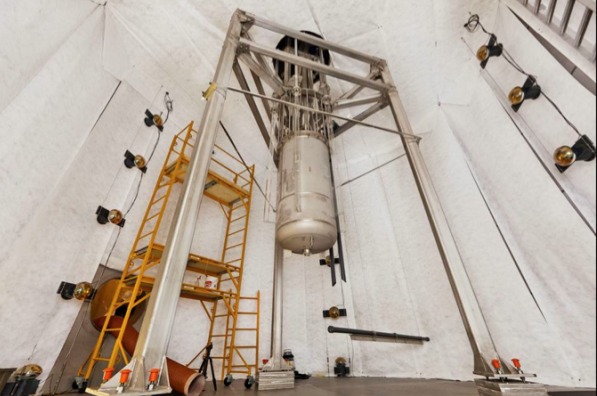
While the world's largest atom smasher was busy finding the Higgs boson particle — thought to explain why other particles have mass — physicists have been quietly building giant underground laboratories deep beneath the Earth.
No, scientists aren't hiding the next James Bond supervillain down there. Instead, they are working more than a mile beneath the Earth's crust to find some of the universe's most elusive particles.
The layers of rock may harbor evidence of a new force and shield delicate experiments from cosmic rays and other high-energy particles, allowing ultrarare particles to reveal themselves. From the unparticle to WIMPs, here are some mysterious particles that could be lurking underground.
The unparticle
Physicists are hunting for a new fundamental force within Earth's mantle. The unparticle, which behaves both as photons and mass-bearing particles do, could be responsible for long-range spin interactions, a new force that causes the electrons in atoms to align their spins over long distances.
To find evidence of the new force, researchers mapped out the electron density and spin within the Earth's mantle and are now investigating whether these subterranean electrons are affecting how neutrons and electrons spin in two experiments separated by about 3,000 miles (4,828 kilometers). If the electrons in the mantle are transmitting a force to those particles in lab experiments, it should change the frequency at which they spin. Then the new force would join gravity, electromagnetism and the strong and weak nuclear forces in dictating the behavior of the universe. [50 Amazing Facts About Planet Earth]
Dark-matter particles
Sign up for the Live Science daily newsletter now
Get the world’s most fascinating discoveries delivered straight to your inbox.
The universe is filled with invisible stuff called dark matter, whose gravitational pull is thought to keep galaxies from flying apart. Leading theories propose that dark matter is made up of weakly interacting massive particles, or WIMPs, that rarely interact with ordinary matter.
Several labs, including the Large Underground Xenon (LUX) Detector in Homestake, S.D., rely on the Earth's crust to shield experiments from cosmic rays that could drown out the few interactions of WIMPs with regular atoms. So far, traces of WIMPs have been few and far between, but with several experiments ongoing, evidence of WIMPs could be revealed within the next few years.
Solar neutrinos
Physicists at Gran Sasso National Laboratory, a particle detector buried a mile beneath an Italian mountain, have caught solar neutrinos in the act of changing types, or “flavors.” The sun's nuclear reactions create these chargeless particles, but leading theories suggest they change flavor as they traveled to the Earth. As a result, physicists looking for certain flavors of solar neutrinos have measured fewer solar neutrinos of those flavors than they expected.
Solar neutrinos rarely interact with matter, but by shooting beams of the particles 454 miles (731 km) from the physics lab CERN to the underground lab in Gran Sasso, physicists managed to catch the particles in the act of changing flavor. The finding confirms that neutrinos do change flavor as they travel from the sun.
Finding geoneutrinos
Neutrinos may form at the sun, but they also are produced from radioactive elements within Earth's mantle. The Gran Sasso Lab also has isolated some of these so-called geoneutrinos, which form when radioactive uranium or thorium decays. The new particles could explain how much heat forms inside the Earth, driving the motion of tectonic plates. To catch these geoneutrinos emanating from the Earth's mantle, the researchers use an oil-based fluid that scintillates, or gives off light, when subatomic particles bump into the fluid. The researchers identified the geoneutrinos because they emit a positron followed by a neutron when bumping into the atoms of the fluid, which gives of a characteristic flash of light.
Nucleon decay
Although many subatomic particles break down into other particles, so far no one has caught the decay of protons or neutrons, which make up the nuclei of atoms. Nucleon decay is predicted by Grand Unified Theories that seek to explain everything in physics.
To find evidence of this rare decay, scientists at the Super-Kamiokande experiment under Mount Kamioka in Japan have spent several years hunting for nucleon decay. Even if it takes protons one hundred hundred thousand million billion trillion (or 10 raised to the 34th power) years to decay, the detectors should be able to find at least a few of these events. So far, though, Super K still hasn't found any evidence of proton decay.
Follow Tia Ghose on Twitter @tiaghose. Follow LiveScience @livescience, Facebook & Google+. Original article on LiveScience.com.

Tia is the managing editor and was previously a senior writer for Live Science. Her work has appeared in Scientific American, Wired.com and other outlets. She holds a master's degree in bioengineering from the University of Washington, a graduate certificate in science writing from UC Santa Cruz and a bachelor's degree in mechanical engineering from the University of Texas at Austin. Tia was part of a team at the Milwaukee Journal Sentinel that published the Empty Cradles series on preterm births, which won multiple awards, including the 2012 Casey Medal for Meritorious Journalism.









